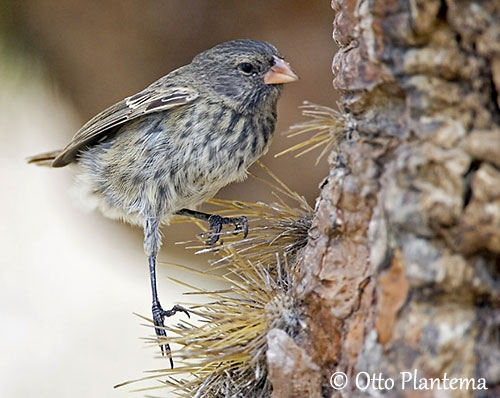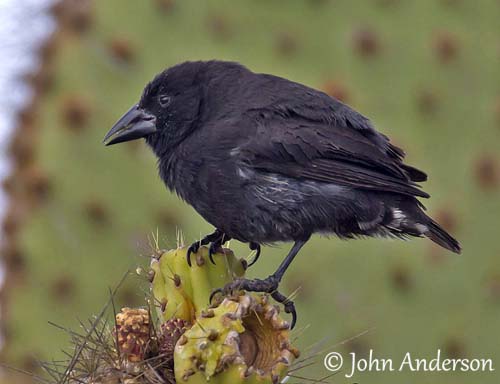
Fr: Géospize des cactus
All: Kaktusgrundfink
Esp: Pinzón de Darwin de los Cactus, Pinzón cactero chico
Ital: Fringuello terricolo dei cactus
Nd: Cactusgrondvink
Sd: Kaktusfink
Photographers:
John Anderson
John Anderson Photo Galleries
Otto Plantema
Trips around the world
Text by Nicole Bouglouan
Sources:
HANDBOOK OF THE BIRDS OF THE WORLD Vol 16 by Josep del Hoyo- Andrew Elliot-David Christie – Lynx Edicions – ISBN: 9788496553781
BirdLife International (BirdLife International)
Neotropical Birds – Cornell Lab of Ornithology
Wikipedia, the free encyclopaedia
Common Cactus-Finch
Geospiza scandens
Passeriforme Order – Thraupidae Family
Darwin’s Finches - Generalities
INTRODUCTION:
The Common Cactus-Finch is often found in areas where Opuntia helleri is growing, a cactus species which provides food almost all year round.
This finch is endemic to Galapagos Islands and occurs on several islands, except those inhabited by the closely related Large Cactus-Finch.
DESCRIPTION OF THE BIRD:
Biometrics:
Length: 12-14 cm
Weight: 20-24 g
The adult male of nominate race is almost entirely black, with browner wings and short tail. The vent is white with black centres on undertail-coverts.
The bill is robust, with spike-like shape and thick base, and downcurved culmen. Like other Darwin’s Finches, the male has black bill during the breeding season, becoming brown with orange base and yellow tip in transition period, and finally orange-yellow in non-breeding.
The eyes are dark brown. Legs and feet are blackish.

The female has dark grey upperparts, head and throat, with pale olive-brown to greyish scaling. We can see a buffy eyering and faint buffy bands on supraloral area and cheek.
Wings and tail are dark olive-brown to blackish, with buffy-brown feathers’ edges, usually less conspicuous on primaries and rectrices.
The underparts are whitish, streaked dark brown, with small streaks on central belly and vent.
The bill is dark with orange base and yellow tip, becoming orange-yellow according to the period during the breeding season.
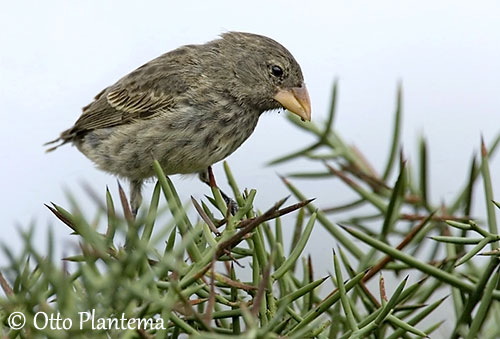
The immature male is similar to other species, an intermediate between male and female with black head and breast, and blacker wings than on female.
SUBSPECIES AND RANGE:
There are four subspecies.
G.s. abingdoni occurs on Pinta in N Galapagos Is. This race is larger with deeper bill and strongly arched culmen.
G.s. rothschildi is found on Marchena in N Galapagos Is. This one has thicker bill and large body.
G.s. intermedia occurs on Isabela, Pinzón, Baltra, Santa Cruz, Santa Fe and Floreana Is, in W, C and S Galapagos Is. This race is larger than nominate with thicker and longer bill.
G.s. scandens (here described) is found on Santiago and Rábida, in C Galapagos Is.
HABITAT:
The Common Cactus-Finch frequents arid lowland areas where cactus Opuntia helleri is present. It is rarely seen higher in more humid areas.
CALLS AND SONGS: SOUNDS BY XENO-CANTO
The Common Cactus-Finch’s call is a high “tip”. The song is a double note “zhhwe zhhwe”, but the bird can utter a more complex phrase “zhh-wah-wah zhh-wah-wah”.
Males usually sing only one song type, and due to the large bill, this species produces relatively lower sounds than other finches.
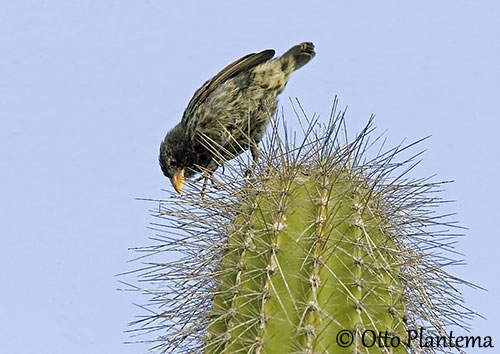
BEHAVIOUR IN THE WILD:
The prickly-pear cactus Opuntia helleri provides food to the Common Cactus-Finch. It feeds on pulp, fruits, flowers and insects. According to the season, the diet varies. The flowering cactus provides pollen and nectar, collected thanks to the specialized beak of this species. Fruits and seeds are important components of its diet too.
During the rainfall, other food items such as shoots, berries, seeds of Tribulus, caterpillars and worms are also taken.
Like most Darwin’s Finches, the Common Cactus-Finch can breed at any time of the year, but mainly during heavy rains and when food resources are abundant.
They are monogamous and the pair maintains a small territory all year round where the nest is built.
The Common Cactus-Finch is resident in its range, and only performs short-distance flights.
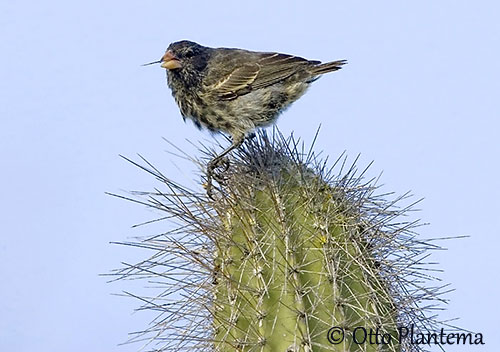
REPRODUCTION OF THIS SPECIES:
The Common Cactus-Finch prefers to breed during the wet season, when food sources are available and abundant. This species may produce more than one brood in wet years.
The male builds the nest, a dome-shaped structure placed in bush or in thick stand of cactus. There is a side entrance towards the top. The nest is made with dry grasses and other plant materials.
The female lays 3-4 whitish eggs with darker markings. She incubates during 12 days. The chicks are mostly fed on insects, pollen and nectar. They fledge about two weeks after hatching.
PROTECTION / THREATS / STATUS:
The Common Cactus-Finch is widespread and common within its range. Populations are stable and the species is not currently threatened.
